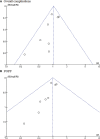Robotic Versus Laparoscopic Pancreaticoduodenectomy: An Up-To-Date System Review and Meta-Analysis
- PMID: 35280811
- PMCID: PMC8914533
- DOI: 10.3389/fonc.2022.834382
Robotic Versus Laparoscopic Pancreaticoduodenectomy: An Up-To-Date System Review and Meta-Analysis
Abstract
Background: Although minimally invasive pancreaticoduodenectomy has gained worldwide interest, there are limited comparative studies between two minimally invasive pancreaticoduodenectomy techniques. This meta-analysis aimed to compare the safety and efficacy of robotic and laparoscopic pancreaticoduodenectomy (LPD), especially the difference in the perioperative and short-term oncological outcomes.
Methods: PubMed, China National Knowledge Infrastructure (CNKI), Wanfang Data, Web of Science, and EMBASE were searched based on a defined search strategy to identify eligible studies before July 2021. Data on operative times, blood loss, overall morbidity, major complications, vascular resection, blood transfusion, postoperative pancreatic fistula (POPF), delayed gastric emptying (DGE), conversion rate, reoperation, length of hospital stay (LOS), and lymph node dissection were subjected to meta-analysis.
Results: Overall, the final analysis included 9 retrospective studies comprising 3,732 patients; 1,149 (30.79%) underwent robotic pancreaticoduodenectomy (RPD), and 2,583 (69.21%) underwent LPD. The present meta-analysis revealed nonsignificant differences in operative times, overall morbidity, major complications, blood transfusion, POPF, DGE, reoperation, and LOS. Alternatively, compared with LPD, RPD was associated with less blood loss (p = 0.002), less conversion rate (p < 0.00001), less vascular resection (p = 0.0006), and more retrieved lymph nodes (p = 0.01).
Conclusion: RPD is at least equivalent to LPD with respect to the incidence of complication, incidence and severity of DGE, and reoperation and length of hospital stay. Compared with LPD, RPD seems to be associated with less blood loss, lower conversion rate, less vascular resection, and more retrieved lymph nodes.
Systematic review registration: https://www.crd.york.ac.uk/PROSPERO/#recordDetails, identifier CRD2021274057.
Keywords: Da Vinci; laparoscopic pancreaticoduodenectomy; meta-analysis; minimally invasive surgery; robotic pancreaticoduodenectomy.
Copyright © 2022 Ouyang, Zhang, Feng, Zhang, Ma and Zhang.
Conflict of interest statement
The authors declare that the research was conducted in the absence of any commercial or financial relationships that could be construed as a potential conflict of interest.
Figures








Similar articles
-
Laparoscopic Pancreaticoduodenectomy Versus Conventional Open Approach for Patients With Pancreatic Duct Adenocarcinoma: An Up-to-Date Systematic Review and Meta-Analysis.Front Oncol. 2021 Oct 27;11:749140. doi: 10.3389/fonc.2021.749140. eCollection 2021. Front Oncol. 2021. PMID: 34778064 Free PMC article.
-
Laparoscopic vs. Open Pancreaticoduodenectomy After Learning Curve: A Systematic Review and Meta-Analysis of Single-Center Studies.Front Surg. 2021 Sep 10;8:715083. doi: 10.3389/fsurg.2021.715083. eCollection 2021. Front Surg. 2021. Retraction in: Front Surg. 2022 Jul 26;9:988654. doi: 10.3389/fsurg.2022.988654. PMID: 34568416 Free PMC article. Retracted.
-
Robotic versus laparoscopic pancreaticoduodenectomy for pancreatic and periampullary tumors: a meta-analysis.Front Oncol. 2024 Nov 19;14:1486504. doi: 10.3389/fonc.2024.1486504. eCollection 2024. Front Oncol. 2024. PMID: 39629002 Free PMC article.
-
Perioperative and short-term oncological outcomes following laparoscopic versus open pancreaticoduodenectomy after learning curve in the past 10 years: a systematic review and meta-analysis.Gland Surg. 2021 May;10(5):1655-1668. doi: 10.21037/gs-20-916. Gland Surg. 2021. PMID: 34164310 Free PMC article.
-
Laparoscopic versus open pancreaticoduodenectomy for pancreatic and periampullary tumor: A meta-analysis of randomized controlled trials and non-randomized comparative studies.Front Oncol. 2023 Jan 25;12:1093395. doi: 10.3389/fonc.2022.1093395. eCollection 2022. Front Oncol. 2023. PMID: 36761416 Free PMC article.
Cited by
-
Robotic pancreatoduodenectomy provides better short-term outcomes as compared to its laparoscopic counterpart: a meta-analysis.Front Oncol. 2025 Jun 18;15:1568957. doi: 10.3389/fonc.2025.1568957. eCollection 2025. Front Oncol. 2025. PMID: 40606993 Free PMC article.
-
Comparing the operative, oncological, post-operative outcomes and complications of robotic and laparoscopic pancreaticoduodenectomy for the treatment of pancreatic and periampullary cancers: a systematic review and meta-analysis with subgroup analysis.J Robot Surg. 2025 Mar 5;19(1):97. doi: 10.1007/s11701-025-02239-y. J Robot Surg. 2025. PMID: 40042699
-
A duct-to-mucosa pancreaticojejunostomy for small main pancreatic duct and soft pancreas in minimally invasive pancreaticoduodenectomy.Surg Endosc. 2023 May;37(5):3567-3579. doi: 10.1007/s00464-022-09830-6. Epub 2023 Jan 9. Surg Endosc. 2023. PMID: 36624217 Free PMC article.
-
Surgery-related factors for pancreatic fistula after pancreatectomy: an umbrella review.Hepatobiliary Surg Nutr. 2025 Jun 1;14(3):442-459. doi: 10.21037/hbsn-23-601. Epub 2024 Aug 21. Hepatobiliary Surg Nutr. 2025. PMID: 40529921 Free PMC article. Review.
-
Robotic pancreaticoduodenectomy in patients with overweight or obesity: a meta-analysis protocol.BMJ Open. 2024 Jul 17;14(7):e080605. doi: 10.1136/bmjopen-2023-080605. BMJ Open. 2024. PMID: 39019640 Free PMC article.
References
Publication types
LinkOut - more resources
Full Text Sources

